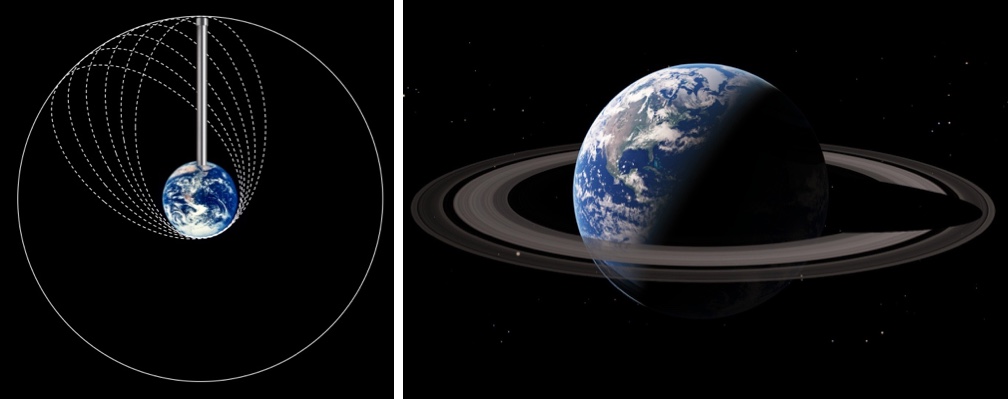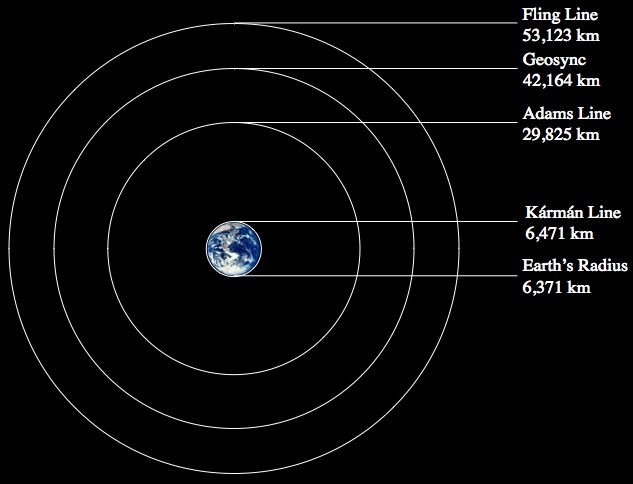Physicist: Like any plumbing fix: it depends on the pipe.
Evangelista Torricelli, the first to measure the weight of the air above us, once famously wrote that “Noi viviamo sommersi nel fondo d’un pelago d’aria.” (“We live submerged at the bottom of an ocean of air.”). That’s a really good way to think about the atmosphere. It’s held in place around the Earth in exactly the same way that the oceans are held where they are; air has weight and gravity holds it down. Gravity doesn’t suddenly go away above the atmosphere. In low Earth orbit (where most satellites can be found) gravity is almost as strong as it is on the surface. So if you pump air or CO2 or any kind of matter above the Kármán Line (the generally agreed upon, but arbitrary, boundary of space), it will still be subject to gravity and will fall. You’ll have yourself a CO2 fountain.

Pumping stuff to just above the atmosphere isn’t an effective way to get rid of it, although it might be pretty if it’s visible from the ground.
If you build your pipe straight up from one of the poles, then it’ll be fountain-like even when it’s millions of miles tall. More importantly, there are no materials that can support such a pipe (it’s important, when building a CO2 pump to the stars, to be realistic). However, a pipe built up from the equator would swing as the Earth turns, and that changes things a lot. Shorter pipes (a mere several thousand km tall) will still act like fountains, but eventually that swinging motion becomes important.
Space elevators operate on exactly this idea; combating gravity using the Earth’s rotation. So figuring out what happens to the CO2 flying out of the top of a very tall pipe boils down to figuring out what would happen if you stepped out of a space elevator at the same height. And since it is entirely possible (but difficult) to build space elevators, this plan could work. In fact, since that elevator would need to be made from carbon nanotubes (no other material is known to be strong enough), we’d be using carbon to get rid of carbon. That’s almost like being efficient!
Douglas Adams once sagely observed that “There is an art to flying, or rather a knack. The knack lies in learning how to throw yourself at the ground and miss. … Clearly, it is this second part, the missing, that presents the difficulties.” Ordinarily this is difficult, but if the tower you throw yourself off is at least around 30,000 km from the center of the Earth, then by the time you get to the ground it won’t be there. Sweeping out a larger circle every day than a point on the ground means the platform you jump from will be moving sideways faster. Once it’s fast enough, when you throw yourself at the ground you’ll literally miss and find yourself in an orbit that skims just above the surface of the Earth at perigee (at the lowest) and returns up to the height of the platform at apogee (at the highest). Lacking an official name, I do hereby declare this to be the “Adams Line”.
Below the Adams Line, all of the CO2 pumped out of the pipe will fall back to Earth. Above the Adams line the released CO2 will find itself in orbit, and we’ll have given Earth a ring system. This wouldn’t be a permanent solution. All of the material in a ring system needs to “stay in its own lane” and orbit in a near-perfect circle (hence: “ring”) or things will run into each other, lose energy, drop into lower orbits and eventually return to Earth. A whole series of overlapping elliptical orbits swerving from the height of the pipe to as low as Earth’s surface would be a very messy, very unstable ring system.

Gases released above the Adams Line will orbit the Earth instead of falling back to the ground. However, gases released at different times will be on crossing (colliding) orbits, that would make Earth’s new rings very unstable.
But the higher the pipe, the more circular the orbit. Once the top of the pipe reaches geosync, it’s in orbit. If you were to step off of a platform you wouldn’t fall, you’d just drift. Gas released at this height wouldn’t swerve between altitudes as it orbited Earth, it would more or less stay where it is and instead would slowly fill up the thin ring that forms geosync. The most expensive and sought-after orbits around Earth would get dirtied up and be far less useful for satellites, but it’s a small price to pay.
We actually have examples of “pipes” releasing gas into their own orbits, so we know more or less what it would look like. Several of the moons in our solar system are geologically active and, having much lower gravity, eruptions from their surfaces don’t necessarily fall back to the ground.

Enceladus’ ice geysers release water into (roughly) the same orbit around Saturn, forming one of Saturn’s many rings.
So between the Adams Line and geosynchronous orbit we’d have a temporary ring system, perhaps giving us time to think up an even crazier plan, and above geosync we’d have a fairly stable ring system (no ring systems are entirely stable). But if we want to get rid of Earth’s CO2 forever, and not just orbitally sequester it, we need it to escape from Earth’s gravity entirely.
At geosync objects orbit Earth once per day. Below that they orbit faster and above that they orbit slower (for example, the Moon, which is way beyond geosync, takes a month to orbit). So if the pipe is taller than about 42,000 km, the CO2 it releases will actually fly upward before falling into orbit, and the taller the pipe, the higher that orbit will be. Beyond about 53,000 km, the top of the pipe will be moving at escape velocity; the CO2 that comes out will fly away from Earth to find its way into orbit around the Sun.
Interesting fun-fact: as measured from the center of any planet, the height of the “Fling Line” is always the cube root of 2 (≈1.26) times the height of geosynchronous orbits. The Fling Line is a really good goal for anyone planning to build a space elevator, because it’s a free ticket to everywhere.

Swing hard enough and eventually centripetal force wins. Above the “Fling Line” (not an official name) stuff that’s released never comes back down.
You might worry about some small amount returning to Earth, but you should be equally worried about someone in Antarctica having bad breath; there’s a lot of room for that problem to diffuse.
So that there is the answer. If you want to solve global warming, you can just gather up and pump CO2 straight up about 53,000 km. Easy peasy.
The weakness of brilliant plans like this isn’t feasibility (this could technically be done), it’s the naysayers who point out that the cure might be worse than the disease. After all, carbon is an essential part of the Earth’s biological and chemical systems. We’ve added about half-again as much CO2 into the atmosphere in the last few centuries, taking us from below 300 ppm to about 400 ppm today. There’s been 400 ppm of CO2 in the Earth’s atmosphere before now, most recently in the Micene 10 million years ago. Way back then life on Earth was doing alright (we got grasslands and kelp forests out of it, which isn’t terrible). Having a bunch of CO2 around isn’t necessarily bad; like highway driving, the danger doesn’t come from any particular situation so much as sudden changes in situation. Given that, suddenly and irreversibly chucking a third of Earth’s CO2 into space has a fair chance of being a really bad idea.
Answer Gravy: If you’re wondering where the various heights came from, you’ll be thrilled to know that you can figure out the height of both the Adams Line and Fling Line (not the official names), with nothing fancier than algebra.
A Keplerian orbit (a regular elliptical or hyperbolic orbit) can be described as:
where r is the distance from the center of the Earth (or whatever you happen to be orbiting), e is the eccentricity (e=0 for a circle, 0<e<1 for an ellipse), is the angle between the lowest point in the orbit and the present position, and p is (basically) a convenient place holder that determines the overall size of the orbit.
If and
are the initial tangential (sideways) and radial (up/down) velocities, h is the initial radius, and
is the initial angular position, then you can solve for the orbit using:
Normally you don’t know what the initial angular position is, you just know how high you are and how you’re moving.
This is a slightly streamlined version of the solution that can be found here. Jumping off of a platform that’s h above the center of the Earth and attached to said Earth means that , where t is the length of one sidereal day (the time it takes Earth to fully rotate once). This is just the distance (the circumference of a large circle, 2πh) over time (one day, t). Since you’re stepping off of a platform, your initial radial velocity is zero,
. Finally, since the question is about the minimum height you could step off such that you would miss the Earth, you’re stepping off at the highest point in the orbit and then dropping, so
. Normally you need both the second and third equations, but knowing you’re staring at the highest point means you already know what
is. One less equation to worry about!
Use the second equation to solve for e:
and then plugging that into the first equation gives us the orbit:
If you plug in , you find that the height of the platform is in fact the height of the platform:
It’s good to double check. But to actually figure out what h is (this was the whole point) you want the lowest point in the orbit to be the Earth’s radius, R=6371 km (any lower and you hit the ground).
This is a fourth degree polynomial in h, and while it is technically possible to solve this by hand, you never want to solve this by hand. So plugging in the gravitational constant, , and all of the details about Earth,
,
,
, and then giving this to a computer to solve for you, you find that one of the four solutions makes sense: h=29,825 km. So if you have to jump into an empty swimming pool, that’s a good height to do it.
The height of the Fling Line (not an official name), f, is a bit easier. You don’t have to mess around with orbits, you just have to set the speed your platform is moving at a given height, , equal to the escape velocity at that height,
:
You can calculate the height of geosync, s, by setting the centrifugal force equal to the gravitational force for an object orbiting exactly once per (sidereal) day, t:
So that’s a cute, probably useless fact; for any planet, the Fling Line is always at times the radius of geosyncronous orbits.








37 Responses to Q: Could we get rid of CO2 if we pumped it through a pipe into space?